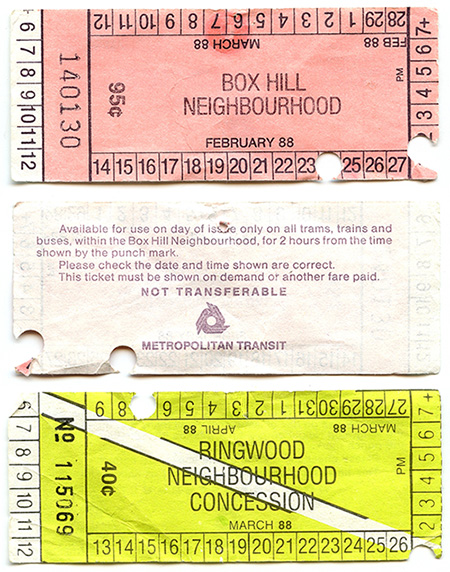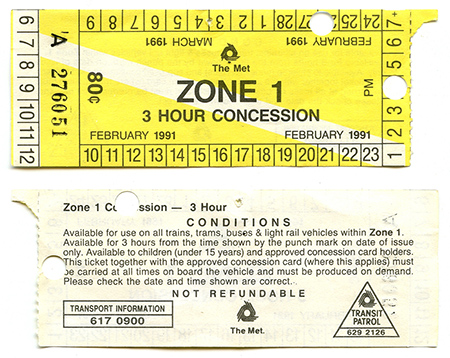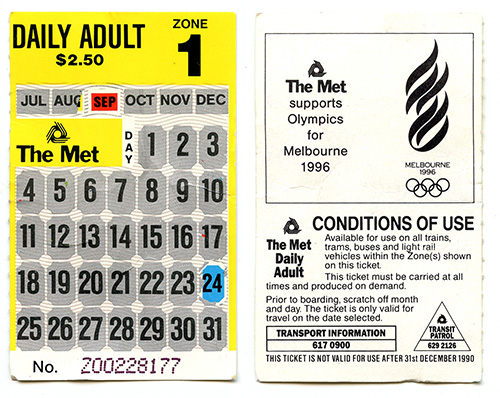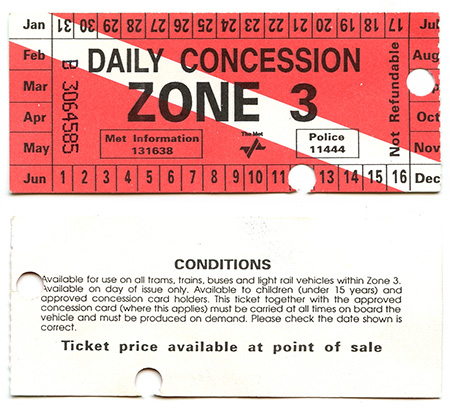Melbourne Transport Tickets of Yore
A look back at earlier versions of transport ticketing in Melbourne, from the 1980’s until today.
I’ve always enjoyed rail travel. When I was a child, my grandmother used to take me on a rail trip every school holidays. We’d pick a different railway service to try and we’d ride the entire line to see what lay at the end (Epping and Port Melbourne were memorable disappointments back then). Interestingly, I kept the tickets that we purchased on those trips and as a result, I now have an interesting collection of tickets from the 1980’s and 1990’s (up to the present).
In the 1980’s, Melbourne’s transport system was operated by a government instrumentality known as the Metropolitan Transit Authority which later traded as The Met. The Authority grew out of a merger between the Victorian Railways Corporation and Melbourne and Metropolitan Tramways Board (M&MTB). The Met was later absorbed into the Public Transport Corporation in 1989 but continued to trade as The Met until the mid 1990’s when the state government decided to tender out the operation of Melbourne’s rail and bus services to private contractors.

Throughout its life, The Met adopted a number of logos. Initially styled as “Metropolitan Transit”, the name was quickly shortened to “The Met” and appeared beside the distinctive green and gold livery used on all vehicles and associated signage. Transport tickets also reflected the changing branding throughout the period.
Met Neighbourhood Paper Tickets
Before Melbourne’s “three zones” system was introduced, the city was divided into a series of arbitrary “neighbourhoods” which neither matched municipal boundaries or made any particular sense. A passenger could purchase a ticket for travel in any single neighbourhood or alternatively buy a multi-neighbourhood pass. A conductor or railway station attendant would punch a hole over the date to indicate the validity of the ticket.

Even as a young child, I recall my grandmother planning our trips and checking carefully on a large map which neighbourhoods we’d pass through so she could purchase the correct tickets. I can only assume that the idea behind this absurd system was to make short local trips cheaper. Neighbourhood ticketing wasn’t popular and only survived six short years.
Met Zone Paper Tickets
Clearly someone at the Ministry of Transport realised that ‘neighbourhood’ zoning was confusing and it was abolished in 1989, replaced instead with a three zones system. Zone 1 included the inner city and suburbs, Zone 2 all of the outer suburbs whilst Zone 3 covered the distant extremities in the east and south.
The use of paper tickets continued, but the colours were changed accommodate the themes associated with each Zone (Zone 1 = yellow; Zone 2 = blue; Zone 3 = red).

Met Zone “Scratch” Tickets (Met Ticket)
The 3-zone paper tickets had not long been in operation when the PTC decided to introduce what could possibly rate as one of the most stupid ticketing concepts in world history. Well, I might be exaggerating a little, but nevertheless the introduction of “scratch” tickets in late 1989 enabled fare evasion to proceed on a grand scale.

Scratch tickets required the holder to self-validate the ticket by scratching off the appropriate month, date (and time for 3-hour tickets). Very quickly, commuters discovered that unless approached by Met staff, they needn’t scratch the tickets at all. Ticket ‘recycling’ became rife. If a ticket inspector did board a train, the ticket holder could validate the ticket in an instant – before the ticket inspector had time to approach the passenger – and thus avoid a fine.
The whole situation apparently became even more farcical when one passenger decided to scratch an extremely fine line across a ticket with the idea of making a bigger scratch the next day, thus using the ticket twice. The passenger was caught by ticket inspectors and the allegation was made that the ticket was not valid as the scratch was too small to see. The matter went to court, which ruled that a scratch of any size was valid, thus opening the system up to further rorting. In the end, the system was abandoned, but not before the Auditor-General had his say:
Although a formal study had not been undertaken by the (Public Transport Corporation), (the Auditor-General’s Office) was advised that fare evasion could actually be as high as 20 per cent or $40 million a year…. Although the PTC estimated that additional fare evasion due to (scratch) Met Ticket(s) amounted to $2.5 million during 1989-90, this amount actually represents the estimated amount of patronage to be regained through revenue protection activities in 1990-91.
Auditor-General of Victora (1990) ‘Special Report No. 15: Met Ticket’
During this period, scratch and paper tickets were used concurrently. Scratch tickets were available from shops whilst paper tickets were available from railway stations, bus drivers and tram conductors.
Met Zone Paper Tickets – Round II
Following the Met Ticket fiasco, it was back to the future with more paper tickets. This time, paper with greater GSM was used.

MetCard
By the mid-1990’s, major changes has taken place. The incoming Kennett Liberal state government introduced widespread reform to public transport, including the removal of conductors from trams, staff reductions and privatisation of transport operations. One of the new government’s objectives was to introduce automated electronic ticketing, something that the previous Cain/Kirner Labor government had been working towards but never quite achieved.
MetCard was progressively rolled-out from August 1996 until April 1998.

The MetCard project was plagued with problems, including the unreliability of the machines which dispensed them (they frequently malfunctioned or were vandalised). Fare evasion became rife on account of the widespread staff cuts. Many railway stations were unmanned and there was no physical barrier preventing people without a ticket from entering or exiting many stations.
But perhaps the biggest problem was their construction. Made of flimsy cardboard with a magnetic strip to store fare data, MetCards frequently failed to validate and could easily be damaged. Anything from an hourly to a monthly ticket were constructed in the same manner. When I commenced university in the late 1990’s, MetCards were in full force. I purchased monthly tickets but typically found that the ticket would fail to validate after about two weeks. Ordinarily, the tickets would have printing on the back to indicate the fare and expiry but after a few weeks of frequent use, the ink tended to fade as well. (My remedy was to place a strip of sticky tape on the back to preserve the ink, technically a breach of the Transport Act 1983 on account of it being a modification to a ticket).
For many years, people could use a defence such as “the ticket machine at my station wasn’t working” or “the ticket wouldn’t validate” as a means to escape a fine.
It was during this time that The Met ceased to be used as a branding tool. Privatised rail and tram operators traded under the name Metlink which also seemed to be the name of an entity that operated as some sort of pseudogovernmental agency. Metlink has since been replaced with PTV or Public Transport Victoria, which is the trading name of the Public Transport Development Authority (PTDA). The PTDA is a state government agency responsible for managing the public transport system and overseeing private operators.
Myki
Eventually it was time for the State Government to look at a replacement for MetCard. The aim was to introduce smart card technology to transport ticketing. This must have been in development for quite some time. In correspondence from Robin Cooper dated 20 May 1999, the Minister for Transport told me:
Trials are currently well underway of a new smartcard called MetXpress. Metcard Xpress will be a stored value, permanent card that enables trips to be registered just by touching the yellow target area on a validator or gate.
What eventually arose many years later was a hideously expensive system called Myki (“my key”). Made of plastic, a microchip was embedded inside to store fare data. The Myki system was progressively implemented between 29 December 2009 and 29 December 2012 at a cost of $1.5 billion. No, that’s not a typo.
Robin Cooper, letter dated 20 May 1999

Myki has been plagued with cost overruns and problems although things seems to have finally settled down now. Myki is the current system in use and I don’t mind it although the removal of ticket machines from trams constitutes a major inconvenience.
So there you have it: A photographic summary of the transport tickets used in Melbourne between 1985 and 2014
Comments
8 responses to “Melbourne Transport Tickets of Yore”
So much I had forgotten, including politician promises that we could could put our Metcards up to the yellow dot on validators to pay our fare. Thanks for the comprehensive record.
Great page, do you know where I might be able to get information about the design of the paper tickets? Specifically the font that was used?
Cheers
I totally totally totally need an answer to this:
Do you by any chance remember a “mascot” of sorts to The Met, circa 1990, called ‘Met Man’?
I remember going on a school excursion in grade 2 on the Met to the city, and we met Met man. I even got a colouring book filled with his adventures.
Yet google yields no results and noone else remembers him.
I need to know…was he real!!!!!
Help a sister out, pleaseee!
Hello Jacqueline, yes, I remember him and I think I may have received the same book. Unfortunately I don’t have it anymore and like you, I cannot find “proof” on the internet.
Very interesting. I worked on the project teams to implement and “fine tune” these ticket systems. Starting from the Neighborhood system to Metcard. We were presented with these silly ticketing systems and told to make them work. Our only major achievement was to create the 3 station overlap between zones which still exists today.
I remember scratch tickets fondly. I used one for eight months on bus 402 to get from Fitzroy to Footscray TAFE before finally one Sunday night I was on a train and some ticket inspectors approached. I quickly scratched off the month and date, but in my haste I scratched the wrong date. They let me off anyway.
Metlink was nothing more than a shopfront. I worked for “Metlink” for a while. When you rang Metlink or any public transport operator you were actually ringing a call centre run by a private company. It was a horrible job. Morale was rock bottom. The public thought we were well paid government employees but in reality we were corporate slaves making minimum wage. They made sure we knew that any error committed by us would cost them $20,000+ and so we lived in terror of errors. Team leaders forever hovering over their computers, checking our call lengths and making sure we hadn’t gone for unauthorised toilet breaks and such. Never again.
That was a blast from the past–thank you for the memories! Removing station staff from all but the major stations made them feel unsafe and also removed access to public toilets: oh the frustration of looking at a locked toilet block when you needed to go.
The scratch tickets were really like the Tatts Scratchies, but with MUCH better odds 🙂
It’s a tall ask, I know, but do you have any info on the cost of the tickets back then? I was looking at the cost of a daily zones 1&2 ticket today using Myki money (I’m an irregular user these days), which costs $9. Using a bit of trial and error to work backwards at https://www.rba.gov.au/calculator/annualDecimal.html I’ve learned that this was about $2.50 in 1982, but I just cannot remember what the cost of a similar ticket was then. Any idea?
A zone 1 to 3 adult daily in 1989 was $4.
$2 concession.